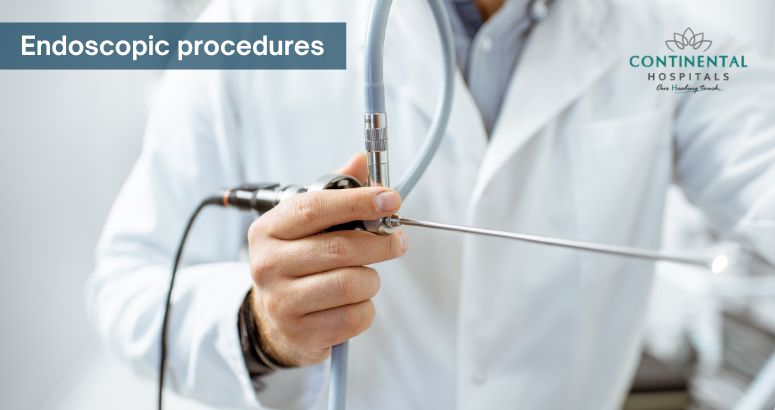- Email: [email protected]
- International Concierge : +91 995 166 0000
- General Enquiry : +91 40 6700 0000
Endoscopic Procedure

Endoscopic procedures have revolutionized the field of medicine, offering minimally invasive solutions to a wide range of medical issues. From diagnosing gastrointestinal problems to exploring internal organs without major surgery, endoscopy has become an indispensable tool in modern healthcare. In this comprehensive guide, we'll delve into the world of endoscopic procedures, exploring their applications, benefits, and advancements.
Understanding Endoscopy:
Endoscopy is a medical procedure that involves the insertion of a thin, flexible tube equipped with a camera and light source, called an endoscope, into the body. This allows doctors to visualize internal organs and structures without the need for invasive surgery. Endoscopes come in various types and sizes, each designed for specific medical purposes.
Types of Endoscopic Procedures:
Upper Endoscopy (Esophagogastroduodenoscopy or EGD): This procedure examines the esophagus, stomach, and upper part of the small intestine (duodenum). It is commonly used to diagnose conditions such as ulcers, gastritis, and gastroesophageal reflux disease (GERD).
Colonoscopy: This procedure examines the large intestine (colon) and rectum. It is often used for screening and diagnosis of colorectal cancer, as well as for the evaluation of symptoms such as abdominal pain, rectal bleeding, or changes in bowel habits.
Bronchoscopy: This procedure examines the airways of the lungs (bronchi and bronchioles) using a bronchoscope. It is used to diagnose and treat conditions affecting the lungs and airways, such as lung cancer, infections, or blockages.
Cystoscopy: This procedure examines the inside of the bladder and urethra using a cystoscope. It is used to diagnose and treat conditions such as urinary tract infections, bladder stones, or tumors.
Laryngoscopy: This procedure examines the throat (larynx) and voice box (vocal cords) using a laryngoscope. It is used to evaluate voice and swallowing disorders, as well as to diagnose conditions such as throat cancer.
Enteroscopy: This procedure examines the small intestine using an enteroscope. It is used to diagnose and treat conditions such as Crohn's disease, small intestine tumors, or bleeding.
Endoscopic Retrograde Cholangiopancreatography (ERCP): This procedure combines endoscopy with X-ray imaging to examine and treat the bile ducts and pancreatic ducts. It is commonly used to diagnose and treat conditions such as gallstones, pancreatitis, or bile duct obstruction.
Endoscopic Ultrasound (EUS): This procedure combines endoscopy with ultrasound imaging to examine the digestive tract and nearby structures, such as the pancreas and bile ducts. It is used for staging and diagnosing gastrointestinal cancers, as well as for evaluating lesions and abnormalities.
Endoscopic Mucosal Resection (EMR): This procedure is used to remove abnormal or precancerous tissue from the digestive tract, such as polyps or early-stage tumors, without the need for surgery.
Endoscopic Submucosal Dissection (ESD): Similar to EMR, ESD is used to remove larger areas of abnormal tissue or early-stage tumors from the digestive tract while preserving the underlying layers.
Benefits of Endoscopic Procedures:
Minimally Invasive: Endoscopic procedures typically require only small incisions or natural body openings, reducing trauma to surrounding tissues. This leads to less pain, faster recovery, and shorter hospital stays compared to open surgeries.
Precise and Detailed Visualization: Endoscopes equipped with cameras provide high-definition images of the internal organs or structures, allowing surgeons to visualize and navigate with precision, even in hard-to-reach areas.
Reduced Risk of Complications: Because endoscopic procedures are minimally invasive, they carry a lower risk of complications such as infection, bleeding, and damage to surrounding tissues compared to open surgeries.
Quicker Recovery Time: Patients undergoing endoscopic procedures typically experience shorter recovery times and can return to their normal activities sooner than those undergoing traditional surgery. This reduces the overall impact on their daily lives.
Less Scarring: The small incisions or natural body openings used in endoscopic procedures result in minimal scarring, which is cosmetically favorable for patients, particularly for procedures performed in visible areas of the body.
Lower Healthcare Costs: Due to shorter hospital stays, reduced need for postoperative care, and quicker recovery times, endoscopic procedures can be more cost-effective than traditional surgeries.
Diagnostic and Therapeutic: Endoscopy serves both diagnostic and therapeutic purposes. Not only can it be used to visualize and diagnose conditions, but it can also be employed to treat various conditions directly during the procedure, such as removing polyps, cauterizing bleeding vessels, or placing stents.
Outpatient Setting: Many endoscopic procedures can be performed on an outpatient basis, allowing patients to undergo the procedure and return home the same day. This further reduces the burden on healthcare facilities and enhances patient convenience.
Lower Risk of Postoperative Complications: Endoscopic procedures often involve less manipulation of tissues and organs, leading to a reduced risk of postoperative complications such as adhesions, hernias, and organ dysfunction.
Improved Patient Outcomes: With advancements in endoscopic technology and techniques, patient outcomes have significantly improved, with higher success rates and lower rates of recurrence for many conditions treated endoscopically.
Advancements in Endoscopy:
Capsule Endoscopy: Ingestible capsules with cameras that allow visualization of the gastrointestinal tract without the need for invasive procedures.
Virtual Endoscopy: Computer-generated imaging techniques that simulate traditional endoscopic procedures, aiding in diagnosis and treatment planning.
Therapeutic Endoscopy: Endoscopic techniques for treating conditions such as removing polyps, stopping bleeding, and placing stents to open blocked ducts.
Endoscopic procedures have transformed the landscape of modern medicine, offering less invasive alternatives to traditional surgery for diagnosing and treating a wide range of medical conditions. With ongoing advancements in technology and techniques, the future holds even greater promise for endoscopy in improving patient outcomes and enhancing the quality of healthcare delivery.
.webp)
